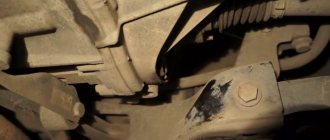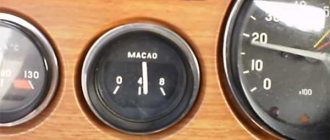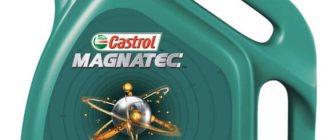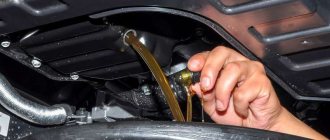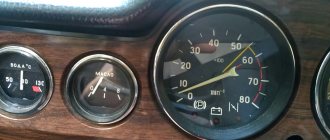How do you currently check the engine oil level?
Despite the fact that cars produced nowadays are stuffed with modern electronics, the oil level in their engine is still checked using a conventional dipstick.
The latter is located in a sealed hole in the cylinder block and there is always easy access to it.
Of course, when the situation changes and data on the amount of oil in the engine crankcase will be displayed in front of the driver on the display, by the way, such cars are already appearing on the market, but mostly they are premium class, for example Mercedes w211 or Volvo XC60 and they do not have direct access to information about the amount of lubricating fluid in the engine, for this you need to activate the electronic dipstick function, but more on that below.
In any case, it is important to know how to properly check the oil level and why it is needed.
This is interesting: How much oil to pour into the gearbox of a VAZ 2106
Which engine should I check the oil level for?
A decrease in the amount of lubricant has a detrimental effect on the operation of the engine; moving components experience increased load and wear out faster. The oil level in the crankcase must be checked regularly. Testing can be carried out “cold”, when the lubricant has completely dropped into the pan, and “hot”.
A prerequisite is a flat area. If the vehicle is located on a slope, reliable data cannot be obtained.
Cold
Proponents of this method argue that in a cold state it is easier to objectively assess the amount of oil.
The nuance is that if you add it to the level, then as soon as the engine warms up, the lubricant will expand and the pressure will exceed the norm.
The consequences are unpleasant - leaks, squeezing out oil seals, lubricant getting into the crankcase ventilation and working cylinders. Loss of performance of the neutralizer.
On a hot engine
The “hot” measurement is carried out after a trip or after the power unit has been running for some time and the temperature sensor shows an average temperature of about fifty degrees. Next, the check is carried out as follows:
- The engine is turned off, the car must stand quietly for five to ten minutes so that the lubricant flows into the crankcase.
- The oil dipstick is removed, wiped with a clean rag, then returned all the way back for five seconds.
There are control marks on the dipstick; by removing it a second time, the car owner evaluates where the oil has left a mark. It is considered normal if it is located between the minimum and maximum. When the level is below the min mark, additional lubricant is required; if it is above the max, the lubricant must be partially drained.
Some vehicle manufacturers provide the possibility of measuring both on a cold (Cold) and on a warm (Hot) engine. For this purpose, two options for control marks are provided on the probe.
Experts recommend carrying out two checks - first “cold”, and then starting the engine. Then the decision to top up, especially if it’s frosty outside, will be more objective. In the summer season, the deviations between the verification options are insignificant, in the winter they are critical.
How the dipstick works
There is no point in considering the design of the probe itself, everything is clear here, let's talk about the marks, because you need to navigate by them when taking measurements.
Most car brands follow one principle: the lower mark L is the minimum level, the upper mark F is the maximum. The designations “MIN” and “MAX” may also be found.
Also on some dipsticks there are marks for measuring the oil level at cold and hot.
But that’s not all; in order to measure readings correctly, you need to adhere to certain rules and conditions, which we will talk about below.
Algorithm of actions - taking measurements
In order for measurements to show the actual oil level in the crankcase, you need to adhere to a certain algorithm of actions:
- The check must be carried out only on a level surface; tilting the engine forward or backward is unacceptable;
- If there are no “hot” and “cold” marks on the dipstick, then you need to check it on a warm engine;
- After you have turned off the engine, let it cool for about 5 minutes. During this time, some of the oil from the system will drain into the crankcase, under such conditions the measurements will be more accurate;
- Prepare a clean rag and remove the dipstick from the hole;
- Wipe the dipstick, avoiding any old grease remaining on it, and insert it back (measurements cannot be taken the first time);
- Remove the dipstick again and take readings;
- The ideal oil level should be 2/3 of the distance from L (lower mark), i.e. slightly above the middle. In rare cases, 3/4 (75%) of the bottom mark is allowed;
- Check the condition of the fluid to see if it needs replacement;
- If the oil level suddenly appears above the F mark, then pay attention to its condition and the color of the smoke from the exhaust pipe;
- If the level is below the L mark, then you need to remember when the last measurements were taken and where the oil went, proceed according to step 9;
- Traces of liquid on the dipstick should be examined carefully; if in doubt, measurements should be repeated;
- Please note that the dipstick may be completely covered with oil from the L to F marks, this especially often happens when fresh working fluid is poured into the engine.
In this case, find the side of the dipstick that is partially dry, this will be the real level. - It is advisable to add working fluid of the same brand as in the engine; read here whether it is possible to mix motor oils;
- Topping steps are 50 - 100 ml, since some engines between the L and F marks can hold from 0.5 to 0.8 liters of oil. So as not to drain the excess later.
Many car owners recommend waiting 30 to 60 minutes after turning off the ignition before checking, so that all the oil will drain into the crankcase and the measurements will be more accurate.
In part, they may be right, but on some cars, for example, the Toyota RAV 4, the engine is designed in such a way that almost all the lubricating fluid drains into the crankcase in 5 minutes and there is no need to wait up to 1 hour to take measurements.
As for other cars, in any engine hot oil will drain into the crankcase quite quickly - 5 minutes is enough, and those milliliters that remain in the engine will not significantly affect the accuracy of the measurement. If there is no level or it is exceeded, it will be immediately visible.
What and how much oil is needed for Polo Sedan
If the oil level is at the bottom mark of the dipstick or the oil level indicator light comes on, then you need to add oil to the engine. Operating a vehicle with an oil level below the MIN mark can lead to engine failure and, as a result, expensive repairs.
If the oil level is at the MIN mark, add approximately 1 liter of oil to the engine. To do this... ...turn counterclockwise and remove the oil filler cap.
Add oil to the engine in small portions. You need to add oil of the same brand that was poured into the engine.
We wait at least three minutes so that the added portion of oil has time to drain into the oil pan, and check the oil level again. It can be standard factory made of plastic or optional, installed by the owner. The second option is usually made of steel sheet.
When removing the standard protection, it is necessary to unscrew the fastening screws starting from the front ones, since the sheet has special latches on the front edge. Then you need to wipe the engine around the oil filler neck and unscrew its cap.
After this, you need to clean the unit pan and drain plug from dirt with a rag. Carefully unscrew the oil drain plug with a wrench, keeping a container ready to collect the waste.
Holding the lid on the last turn of the thread, you need to bring the container, unscrew the cap completely and immediately put it aside. This operation should be carried out carefully and quickly, since the oil is hot and the pressure will be quite significant.
When to change engine oil
After the main volume of liquid has drained, you need to place a container on the bottom of the pit or the floor of the room to collect the remaining oil from the crankcase. It takes at least minutes to completely drain the lubricant.
Some car owners additionally pump out residues from the recesses of the pan using a medical syringe and an extension tube from a dropper placed on the spout. New engine crankcase drain plug.
Step-by-step instructions It is best to carry out work on changing the oil in the Polo sedan engine on an overpass or in a garage pit: You need to warm up the engine, which will ensure the appropriate fluidity of the fluid, which will quickly drain from the crankcase of the unit. The car warms up and is driven onto the overpass, after which you should place a container with a capacity of at least 4 liters under the drain hole in the crankcase.
Having decided on the brand of lubricant, you need to figure out how many liters of fluid to pour into the engine compartment. Lubricants for the Volkswagen Polo sedan are sold in various containers: For the new engine of the Polo sedan, a four-liter canister is suitable.
Polo Sedan
A unit with a significant mileage will consume more oil, so it is best to stock up on a five-liter bottle in order to be able to add a certain amount of liquid. Dealers advise changing the fluid every 15 km. Guide to changing the oil yourself If you don’t have the time and money to travel to a service center, you can do the change yourself.
checking the oil level on a Volkswagen Polo
Analogues will cost half as much, for example: Also, do not forget that you need to change the sealing washer of the pan plug or the drain bolt assembly - N costs 95 rubles.
Examination
- Remove the dipstick and wipe with a clean cloth.
- Then insert the dipstick all the way and remove it again.
- The oil level is OK if it is in zone -B- on the dipstick. If the oil level is in zone -C-, it is necessary to replenish the level to zone -B-. If the oil level is in zone -A-, then there is no need to add oil.
Attention: If too much oil has been poured into the engine (above zone -A-), the excess must be sucked out, otherwise the engine seals and catalytic converter may be damaged.
- Under heavy loads on the engine, for example, during long trips on the highway in the summer, when operating a vehicle with a trailer or when traveling on mountain roads, the oil level should be located on the dipstick in the upper part of zone -B-.
- The engine is filled with engine oil through the filler neck in the cylinder head cover. When topping up, use standard oil, do not use any additives to the oil, see the “Lubrication System” section.
- Insert the dipstick and screw on the oil filler cap.
Previous articles Engine/engine compartment: visual check of tightness of connections Polo 2001-2009: Maintenance Engine and exhaust system Polo 2001-2009: Maintenance Maintenance work Polo 2001-2009: Maintenance Additional work as part of maintenance Polo 2001- 2009: Maintenance Maintenance card Polo 2001-2009: Maintenance Maintenance with engine oil change Polo 2001-2009: Maintenance Maintenance at scheduled intervals Polo 2001-2009: Maintenance Maintenance at unregulated intervals (Longlife-Service) Polo 2001-2009: Maintenance
The following articles Changing the engine oil/replacing the oil filter Polo 2001-2009: Maintenance Draining the engine oil Polo 2001-2009: Maintenance Replacing the oil filter Polo 2001-2009: Maintenance Refilling with engine oil Polo 2001-2009: Maintenance Checking the level/refilling coolant Polo 2001-2009: Maintenance Checking/increasing the concentration of antifreeze Polo 2001-2009: Maintenance Removing water from the fuel filter Polo 2001-2009: Maintenance Replacing the fuel filter Polo 2001-2009: Maintenance Engine air filter: replacing the filter element Polo 2001-2009: Maintenance Checking the poly V-belt Polo 2001-2009: Maintenance
Visitor comments
This is interesting: What kind of oil to put in a Renault Kengo box
How to determine the oil level using a Volkswagen Polo dipstick
Car manuals Manuals. Manuals Knowledge base Auto history.
Volkswagen Polo Service and operation. Maintenance 3. Maintenance work 4.
Checking the oil level
Electrical system 5. Chassis 6. Brake system 7.
Engine 8. Lubrication system 9. Cooling system Engine control system Ignition system Diesel engine injection systems Power supply system Exhaust gas system Internal equipment External part of the body Electrical circuits. We bring to your attention the address and telephone directory of automobile enterprises providing goods and services to Volkswagen cars:.
VIDEO: Volkswagen Polo Comfortline 2021: determine how much oil to fill using the dipstick
Car disassembly, dismantling Auto parts stores Services, technical. Checking the oil level. Location of the oil dipstick on a 2.3 liter engine D, D, D.
Where is the dipstick located on the automatic transmission? Let's touch on FORD, KIA, VOLKSWAGEN, CHEVROLET
Location of oil dipstick 1 and oil filler cap 2 on a 2.9 liter engine D, D, D. It is best to check the oil level at each refueling. The oil dipstick, as you know, is located in front of the engine on the side. In Fig. It is better to check the oil level before leaving with the engine still cold. Wipe it with a lint-free cloth or paper towel.
Insert it back all the way, wait a little and take it out again. If it is between two divisions, everything is fine. The oil volume between the lower and upper divisions of the dipstick corresponds to 2 liters.
Thus, if the oil level is in the lower third of the scale or the control lamp is on, it is convenient to use a one-liter canister to top up. When topping up from a five-liter canister, use a funnel. Oil is poured through the neck in the engine head cover. With a calm driving style, the oil level may be in the lower third of the scale.
Volkswagen Polo Sedan, l. With. — self-repair
When actively driving or towing a trailer, it is recommended to maintain the oil level closer to the upper mark. With a larger volume, the oil cools the engine better. Don't add too much oil.
Lada Granta
The algorithm of actions is the same (see above). But when measuring the oil level in a Lada Granta, there is one feature that many people do not know about.
The crankcase pan is structurally equipped with an antifoam plate, which is located parallel to the bottom of the pan.
It serves to calm and prevent foaming of the liquid and for normal operation of the oil pump.
This plate has two holes, the main one for the oil intake and the second for the dipstick.
In the Lada Granta, this hole is slightly offset, so when measuring the oil level, the dipstick rests against the edge of this hole and does not go in completely.
Those who know about this get used to it and no problems arise, but those who don’t know how to bend the feeler gauge.
But this is not the only problem. When removing the probe, it touches the edge of the hole in the defoamer plate, which is at the level of the top mark when the probe is inserted.
As a result, the oil film moves smoothly along the dipstick from mark F to L, which misleads the driver. Therefore, here you need to adhere to the rule - the level is checked not at the edge of the oil on the dipstick, but in a dry place. The probe needs to be rotated, viewed and analyzed.
Changing the oil in a VW Polo car engine
Changing motor lubricant is not such a complicated operation, so to save time and money it can be done at home. Currently, there is a huge amount of textual information and video materials on the Internet, which you should first read carefully. After this, you should establish the order in which each procedure is performed and follow it flawlessly. In this case, you will protect yourself from making any mistakes.
Other VAZ cars
Let's look at how to check the oil level on VAZ series cars using the example of the VAZ 2112 and Lada Priora 16 valves.
Level measurements on these vehicles are carried out only on a warm engine. The probes here have a special appearance - a corrugated area with marks along the edges without letters.
Therefore, if the engine is cold, you will have to start it and warm it up until the fan turns on.
Then turn off the engine, wait 3-5 minutes until the oil drains into the crankcase and take measurements, see the algorithm above.
Since the dipstick itself between the marks has a corrugated shape, this causes a problem for many drivers.
Everything is simple here - the working fluid must be in the grooved zone, then the level is considered normal. But where this place should be, opinions differ.
Experienced drivers recommend proceeding from the operating conditions of the vehicle.
If the VAZ 2112 and Lada Priora are operated under normal conditions on flat terrain, then it is considered normal if the oil level is in the middle in the corrugated zone.
If cars are driven on moderately rough terrain, then the normal level may be 2/3 from the bottom mark in the corrugated zone, and if in mountainous terrain, then 3/4.
Also, many experienced car owners rely on the number of engine revolutions.
If during driving the number of crankshaft revolutions does not exceed 3000 rpm, then the oil level can be kept in the middle, if more than 4000 - at 3/4 of the lower mark. Filling 1 liter means raising the level from the lower to the upper marks.
Oil change for Polo sedan
Changing the oil begins with warming up the power plant. Having opened the garage, to carry out the next maintenance, you need to start the engine.
Do not use jacks during work. Is it dangerous. There is no guarantee that the vehicle will be positioned correctly horizontally. In addition, it is not possible to reach the service area.
- First, remove the filler cap. The hole must be covered with a clean rag to prevent dirt and debris from getting inside the Volkswagen Polo working unit.
- Using Torx “T-25” and head No. 13, we dismantle the protection, if provided class=”aligncenter” width=”750″ height=”484″[/img]
- Using previously prepared clean rags, you must carefully clean the drain plug and the surface around it from dirt.
- We install a container above the crankcase to receive used oil.
- Using a number 18 wrench, you need to slightly loosen the oil drain plug. Goal: unscrew it with your own hands to receive it in a plastic waste container.
- After making sure that the pressure has almost disappeared, you need to update the oil filter. Usually it is unscrewed using a chain puller, as shown in the figure.
- Visually control the oil leakage. If it no longer drains, you need to tighten the plug.
- Fill in new engine oil to ¾ of the total volume recommended by the manufacturer. Use a dipstick to check the oil level in the engine. Add it to the middle of the mark.
- Drive 5 kilometers. Turn off the engine. Let it drain to the bottom of the crankcase.
- At the end of the work, we check the level of the filled engine oil. Don’t forget to inspect the vehicle to ensure there are no leaks in the service area.
Remember to periodically check the engine oil level.
Toyota RAV 4, Corolla, Camry
The oil level in Toyota RAV 4, Corolla and Camry cars is checked using the algorithm described above.
Since these models do not have o and “hot” on the probes, the engine warms up, waits 5 minutes and measurements are taken. You need to focus on all the same indicators - 0.5 (middle of the probe), 2/3 and 3/4.
On Toyota RAV 4, depending on the engine model, the dipstick may be corrugated on one side or smooth on all sides. There may also be different designations - Max and Min or F and L.
The Toyota Corolla dipstick is smooth without any letter designations, there are only lower and upper marks. Measurements are carried out the same way.
On a Toyota Camry, depending on the engine model, the dipsticks can also be different, one may have the letters F and L, the other may simply have marks.
But this does not change anything; the oil level on the Toyota Camry is checked in the same way as indicated above.
Oil level on dipstick
Checking the oil level in the oil pan with a dipstick is part of the TO-1 regulation, which involves checking the oil level in the engine after each long-term parking of the car. More details about choosing oil can be found in the material: “Choosing which engine oil is best to fill in a Volkswagen Polo.”
In the car manual, the procedure for checking the oil is explained clearly and clearly.
The car should be level and not tilted. It is most convenient to do it in the morning immediately before the trip.
The oil will drain overnight from the upper internal parts of the engine and the dipstick and settle in the sump. It is convenient because there is no need to wipe the dipstick, but simply pull it out and determine the oil level, which should be between the upper and lower marks . This level is considered normal .
The oil level between the marks on the dipstick is normal!
Exceeding level
- About the expert:
I own a Renault Megane 2, before that there were Citroens and Peugeots. I work in the service area of a dealership, so I know the car inside and out. You can always contact me for advice.
Exceeding the oil mark is undesirable, since excess oil will create higher pressure inside the engine, which can lead to leakage through the seals.
Level lower risks
The oil level below the lower mark during constant driving will lead to insufficient oil supply to the rubbing parts of the engine, the crankshaft bearings, the gas distribution mechanism, and the connecting rod and piston group. Especially during steep descents and ascents when traveling over rough terrain.
This is very bad, to put it simply!!!
If the level is low, it is necessary to add the missing volume by first unscrewing the cap through the filler neck. Repeat the check procedure and only after making sure that the oil level is located in the middle of the MIN and MAX marks can you start the engine and start driving.
It is necessary to add the exact oil that was filled. And the best choice for Volkswagen Polo would be branded oil from the manufacturer of the same name.
- About the author:
- Latest articles:
Briefly about myself: a car fanatic. Car dealership managers know me by sight; I test all the new products. I change three cars a year. My wife laughs, she’s had 4 Citroens for 5 years now, and I’m still on a new one. I sleep with the keys, the garage is my second home!
- Review of the Ford Explorer 2021 model year and start of sales in Russia - 01/14/2020
- When will the new 2021 Toyota CAMRY be released for Russia - 01/14/2020
- Choosing antifreeze in Mitsubishi Lancer 10 with 1.5 engine - 10/07/2019
- Next material Oil volume in the Volkswagen Polo sedan 1.6 engine (how much for replacement)
- Previous article Choosing spark plugs for Volkswagen Tiguan
Tags: Questions Polo Sedan
How to Check the Oil Level in a Polo Sedan
Due to the loss of its own parameters, engine oil requires periodic replacement. Even when the engine is running, it loses its ability to work (it becomes oxidized, enhanced by additives, and becomes contaminated). There may also be coolant entering the crankcase, diluting the oil with fuel, and severe soot contamination. What high-quality oily substance, along with effective additives, suppresses soot and other oxidizing materials while maintaining a clean surface inside a Polo engine?
When replacing water in the engine of a Polo sedan, you should be well aware of how much and what substance to change. So, what fatty substance do you recommend consuming? Obviously. original made by Volkswagen (ACEA A2 / A3 501 01, 502 00, 503 00, 504 00, with viscosity 5W40 / 5W30). These oils are produced in Europe (Germany).
Some motorists use oil from other manufacturers. But keep in mind: be sure to follow the viscous car manufacturer's recommendations and always check the lubricant level.
Basically! To make Volkswagen Polo work properly, you need to use 3600 ml of water for the engine (check the dipstick to check the amount. between minutes and max.)
It's best to get your Polo engine oil supplied so you can always raise the level and fill it up if you want. Also, always consider the mileage of your own vehicle.
According to the manufacturer's recommendation, the change is made every 10-15 thousand km. But repeatedly this procedure is considered in more diverse ways. For example, in the cool season, it is recommended to change the fat every six months, and use the machine in a big city. every 4 months.
When operating a polo sedan in difficult conditions, it is better to replace the oily fluid twice as often (7-8 thousand km). Difficult conditions:
- traffic in a big city, in traffic jams;
- permanent short road;
- long-term car parking;
- driving in dusty and dirty conditions;
- low quality of spilled fuel.
The following types of lubricants exist:
What about scratches?
In the comments, we are constantly asked questions about the fact that glass is in a liquid state, and in general, how much advertising for automotive technology is currently in the current market segment. In the end, they decided to test in practice how true this was. Say yes, we used 3 tools. One medicine turned out to be such; after application, the burned spot remained in this position. The second agent in the application showed absolutely no effect.
Ford Focus 2
The car is also placed on a flat surface, the engine is turned off and wait 5 - 10 minutes until the oil drains into the crankcase.
The measurement algorithm is no different from that described above. Everything is also checked the second time.
The Ford Focus 2 dipstick has only risks, there are no letter designations. There are also no indicators for “cold” and “hot”, so we take measurements only on a warm engine.
Allowed oil level readings are 0.5 (the middle between the marks), 2/3 and 3/4 of the distance from the bottom mark.
Above the top line, drain off the excess; below the bottom line, add more.
Volkswagen Polo sedan
The dipstick for measuring the oil level in the Volkswagen Polo sedan engine has two marks, lower and upper, in the grooved area. Do not confuse with marks further down and up the dipstick.
Measuring the level is no different from the previous ones, just place the car on a flat surface, turn off the engine and wait 5 - 10 minutes.
The check is also carried out the second time. The oil level should be midway between the marks in the grooved area or 2/3 and 3/4 of the distance from the bottom mark.
How to check the oil on a specific car
For most power units, except for V8 gasoline and V6 diesel engines, the test conditions are similar:
- after turning off the engine, you need to wait about a quarter of an hour for the lubricant to drop into the pan;
- strict horizontal position, the site should not be on a slope;
- oil temperature is not less than 60 degrees.
There are certain nuances characteristic of different car models that have to be taken into account.
Volvo XC60
The computer system of cars from 2021 allows you to take measurements simply and without getting your hands dirty. You need to insert the smart key fob into the device, turn the ignition key to the second position without starting the engine, select the “Oil level” option, and the system will display the necessary data on the head unit display.
Mercedes E-Class (W211)
The Mercedes E-Class (W211) also does not have a dipstick, so the check is carried out through the dashboard. First, the key is set to the first position, then the mileage reset button is pressed for 20 seconds until the sound signal is heard, after which you need to press the cursor button on the steering wheel. The head unit will display the necessary data on the screen; you can get information in liters if you move the key to the second position.
Lada Priora
The domestic Lada Priora is equipped with a standard oil dipstick, so you need to control the level of the lubricant in a standard way.
Volkswagen Polo
On a Volkswagen Polo, you can control the lubrication level by placing the car on a level surface and using the usual algorithm:
- turn off the engine and wait;
- pull out and remove any remaining oil from the dipstick;
- insert until it stops, remove again to assess the level of the lubricant according to the min/max marks.
Volkswagen Touareg
The Volkswagen Touareg model does not have a standard oil dipstick, but has an electronic one. The check is carried out from the car's head unit: the ignition is turned on, the system is activated with the Car button, and “Service” is pressed.
Hyundai Solaris
On the Korean car model, the oil dipstick is located in the front of the engine compartment. The procedure for checking the oil level does not differ from the standard one. When pouring lubricant, you need to check the level with a dipstick, waiting up to three minutes before pulling it out so that the lubricant has time to fall into the crankcase.
Controlling the amount of lubricant is important for safety on the road and will allow you to delay major engine repairs and prevent breakdowns that occur due to increased wear. Every automaker always describes how to check the engine oil level in the owner's manual. Once you receive a new car, you should carefully consider this information so that there are no unpleasant surprises on the road in the future.
Volvo XC60
Volvo XC60 cars are equipped with D3, D4, D5 engines, which can be equipped with either two types of probes at the same time, electronic and conventional, or only electronic.
For example, on the Volvo XC60 D5 205 and 2.4D 175 there are two types of dipsticks, but the usual dipstick is very small and is located at the very bottom of the engine and is difficult to reach. You need to either lift the car or drive it into a pit.
Therefore, they mainly check the oil level on the Volvo XC60 electronically and for this:
Audi Q5
On the AUDI Q5, the oil level is also checked with an electronic dipstick, but here the manufacturer has gone overboard with this matter. Why? You will understand further.
Algorithm of actions:
Renault Megane 2
To check the oil level in Renault Megane 2, you first need to find the dipstick, which is not easy to do the first time.
The dipstick is located at the bottom of the engine on the radiator side to the right of the oil filter.
It is not noticeable and is not large in size.
The inconveniences are obvious - the probe is far away and inconvenient to reach.
The oil level is measured in the same way as in other cars, using two marks. There are no letter designations on the dipstick. But this also has its own characteristics.
So, we have looked at the main rules and conditions under which you will measure the oil level in the engine crankcase on any car.
Of course, each car model has its own nuances that you need to know about, especially with regard to the design of the probe and its principle of operation (regular or electronic).
Therefore, as an example, we have given several car models in which measuring the oil level in engines requires certain knowledge and experience.
Checking the level and adding oil to the engine Volkswagen Transporter T4 1990 - 2003
Parts and consumables:
- Engine oil (5w40, 5w30)
- Fabric gloves (if necessary)
- Rags
Notes:
Approximately every 600-1000 km or before a long trip, you need to check the engine oil level and top up if necessary.
The engine should not consume more than 1.0 liters per 1000 km. oils Higher consumption is a sign of wear on the oil seals, piston rings or oil seals.
Volkswagen recommends oil that must meet company standards - No. 505.00 or No. 506.00. Be sure to make sure that the oil you fill meets this standard.
To ensure trouble-free operation of your car's engine, you need to regularly check the engine oil. This is the simplest procedure that requires maximum regularity.
Volkswagen Transporter T4 engine oil is a lubricant between the moving elements of the engine. Insufficient oil level will lead to premature engine wear and contamination.
Checking the oil level should be carried out no earlier than 30 minutes after stopping the engine. If the test is carried out immediately after turning off the engine, some of the oil will remain in the upper part of the engine and will not have time to drain into the sump, as a result of which the measurement result will not be correct.
Add Volkswagen Transporter T4 engine oil of the same brand, viscosity and type as that previously filled.
1. Place the car on a flat horizontal surface. Open the hood and lock it in the raised position. The oil level indicator (dipstick) with a yellow plastic tip is located on the front right side of the cylinder block, next to the engine oil filler neck.
The neck for filling oil into the engine is located on the cylinder head cover.
2. Before checking the level, remove the Volkswagen Transporter T4 oil dipstick from the engine guide tube.
Note:
Do not put a lot of effort into removing the dipstick. A little twisting and pressing is required just to move it out of position.
3. Wipe the dipstick with a rag until it is dry.
4. Insert the oil dipstick back into the engine guide tube as far as it will go, wait a few seconds for the oil to leave a mark on the dipstick and remove it again. The oil level is considered normal if it is between the upper and lower marks.
5. There are marks at the end of the probe:
- if the oil level is within area A, then the engine oil level is normal and there is no need to top it up;
- if the oil level is within area B, then the amount of oil in the engine as a whole is sufficient, but it can be added to mark B;
- If the oil level is in area C, then the engine should be topped up with oil to at least a level within area B.
6. To add oil, turn the oil filler cap counterclockwise and remove it.
7. Add the required amount of engine oil, monitoring the level using the dipstick. Before removing the dipstick, wait 3 minutes for the oil to completely flow into the crankcase. The amount of oil between the upper and lower marks is 1.5 liters.
Note:
Under no circumstances should the upper mark (A) on the dipstick be exceeded. Therefore, it is better not to try to super-precisely fill the car engine with oil to the top mark. Excess oil will be quickly consumed, and its burnout will contribute to the formation of excessive deposits on engine parts. In addition, when the permissible level is exceeded, the crankshaft whips and foams the oil in the crankcase more intensively, which can in some cases contribute to deterioration of lubrication.
Add oil slowly. It is recommended to do this in small portions. It is necessary to pause periodically so that the oil has time to settle into the crankcase.
8. After adding oil, screw the oil filler cap tightly. Clean up spilled liquid with a rag.
Note:
Operating a vehicle with a level below the norm (mark C) can lead to engine failure and, as a result, expensive repairs. If the engine oil level of the Volkswagen Transporter T4 is higher than normal (mark A), this can cause an increase in oil consumption due to burnout, oiling of the spark plugs and increased formation of soot.
Prolonged and frequent contact of exposed areas of the body with used motor oil can lead to various skin diseases, including dermatitis and malignant skin tumors. Therefore, you should avoid excessive contact with oil and thoroughly wash off any dirt from your skin after work.
The article is missing:
- Photos of parts and consumables
Source: carpedia.club
Replacement frequency, what oil to fill
According to the manufacturer's regulations, service changes of engine oil for the Volkswagen Polo Sedan are carried out after 15,000 kilometers or at intervals of 1 year. But some car owners consider this interval to be a little too high, recommending that it be shortened taking into account operating conditions.
The original oil that the manufacturer recommends is Volkswagen Special Plus 5w-40, also known as VAG Special G 5w-40. Available in 1 liter G 052 167 M2 and 5 liter G 052 167 M4.
In addition, it is also recommended to use Castrol lubricant, as evidenced by the inscription on the engine oil filler neck. The Castrol EDGE 5W-30 A3/B4 marking has all the necessary approvals. The inscription Professional and the VW sign may also be present.
Sometimes Polo car owners have a misunderstanding about what viscosity should be chosen: 5w30 or 5w40. The fact is that the manufacturer gives a recommendation when choosing to focus on the VW 502.00 tolerance. And the viscosity is selected based on the climatic zone of use of the machine. By the way, it can be 0W30. But most often, dealers in central Russia fill in 5W-40.
The manufacturer also allows the use of analogues that meet the approval of the VAG concern: VW 502.00. The following brands are most popular among car owners:
- Castrol Magnatec 5W-40 A3/B4
- Liqui Moly Synthoil High Tech 5W-40
- Mobil 1 FS X1 5W-40
- Motul 8100 X-cess 5W40
- RAVENOL VollSynth Turbo VST 5W-40
- Shell Helix Ultra 5W-40
- Total Quartz 9000 5W-40
- Valvoline Synpower 5W-40
- ZIC X9 5W-40
- Lukoil Genesis Armortech 5W-40
From this list, anyone can choose based on preference, price or love for the brand.
How much oil is in the engine lubrication system, volume table
| Model | Engine capacity | Motor marking | How many liters of oil are in the system | Original oil / factory filled |
| Volkswagen Polo sedan | gasoline 1.6 | CFNA | 3.6 | Volkswagen Special Plus 5w-40 |
| CFNB | ||||
| CFW | ||||
| CLSA | ||||
| C.W.V.A. | ||||
| gasoline 1.4 | CZCA |
When to change the oil in a Volkswagen Polo engine
Officially, an oil change should be performed every 15 thousand km. or once a year. Moreover, such intervals are more suitable for gentle operating conditions. If conditions are difficult, then replacement intervals need to be shortened.
Severe operating conditions are considered to be:
- “ragged” driving pace in the city;
- constant acceleration and stopping;
- driving at low speeds;
- easy in traffic jams;
- transportation of goods, towing a trailer, etc.
It is important to understand that in such conditions the oil “ages” much more actively, as a result of which it is replaced every 8-10 thousand km. If fuel of medium or low quality is used, the car is operated irregularly and the mileage is short, then it is better to change the engine oil once every 6-7 months, and not once a year. The reason is the natural “triggering” of special additives in motor oil.
What third-party oil should I fill in the Volkswagen Polo?
To be fair, we note that there are no proprietary formulations produced at Volkswagen AG factories. The automaker orders consumables from partners.
Therefore, you can safely use any lubricants that meet the following conditions:
- approval VW 502 00 or VW 504 00;
- viscosity 5W30 or 5W40 (check the routine maintenance instructions).
Here is a partial list of 100% compatible oils with VW approval:
- Liqui Moly Leichtlauf High Tech 5W-40
- WOLF EXTENDTECH 5W40 HM
- Liqui Moly Special Tec LL 5W-30
- Motul Specific VW 5W-40
- Castrol MAGNATEC 5W-40
